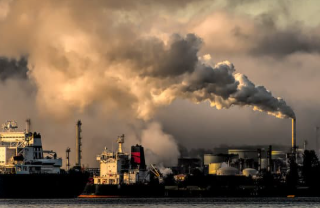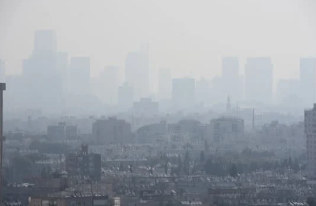Climate Change Risks Undoing Decades of Progress Toward Clearing the Air
- Environmental Health Project

- Apr 24
- 7 min read
Air pollution is a known threat to public health. The World Health Organization (WHO) estimates that as many as 4.2 million premature deaths occur each year because of exposure to outdoor air pollution alone. While air pollution continues to worsen climate change and raise the risk of serious health impacts for people across the globe, we can take many positive actions today to reduce this risk and save lives.
Looking Back at Historic Air Pollution
The understanding of air pollution as a direct health risk has a long history. After massive industrialization in the 18th and 19th centuries, many cities began recognizing the impact of poor air quality on the health of residents. New York City and London, both hubs of the Industrial Revolution, suffered directly from the link between pollution and increased disease outcomes. Images from the 1850s show smoggy cities built around factories with towering smokestacks and blackened building facades from soot and smoke. The burning of coal and the generation of steam was the main driver of pollution. Cities in Appalachia, fed by coal mined in the region, suffered from poor air as well, with Pittsburgh earning the descriptor “Hell with the lid off” due to pollution that would block the midday sun in the 1940s and 50s.

Continued industrial activity and the Pittsburgh region’s geography proved be a deadly combination. In Donora, PA, in October 1948, severe air pollution from the Donora Zinc Works became trapped by a strong temperature inversion. The pollution event led to the asphyxiation deaths of 20 people and serious illness in over 7,000 others. The Donora Smog is credited with inspiring the federal Clean Air Act, which has eased pollution from a variety of sources.
In 1966, a major New York City smog event drew the public eye: a haze of carbon monoxide and sulfur dioxide hung in the city’s stagnant air for three days, sourced from a mix of traffic, industry, and trash incineration. Ten percent of the city's population experienced adverse health effects, such as coughing, wheezing, and shortness of breath. Later studies found that 168 deaths had been caused directly by the smog.
The Scope of Climate Change’s Impact on Air Pollution
While action like the Clean Air Act has curbed much of the country’s visual air pollution, the problem still persists and will be exacerbated by climate change. A WHO report estimates that 99% of the world’s population is exposed to air that exceeds air quality guidelines.
Climate change risks undoing much of the progress that improved health outcomes for millions of people. Temperature inversions like the one that contributed to the Donora Smog and others that regularly plague the Pittsburgh area are predicted to become more frequent as the planet warms. Weather conditions that will not allow the dispersion of pollution make the regulation and reduction of emissions even more important. In addition, most secondary pollutants, such as ozone, are more likely to develop at higher temperatures. In a warmer world, scientists expect more hot sunny days with unhealthy levels of ground level ozone.

Fossil fuel development, particularly oil and gas development, is the main driver of climate change. The production and use of fossil fuels release significant amounts of greenhouse gases (GHG), such as carbon dioxide (CO2), methane (CH4), and others, all of which trap heat from the sun that would otherwise escape into the atmosphere. According to the International Energy Agency (IEA), CO2 emissions from fossil fuel combustion accounted for nearly 75% of global greenhouse gas emissions in 2022.
Shale gas development operations directly emit several air pollutants that contribute to health harm and climate change. These include VOCs emitted during drilling and fracking, which contribute to ozone formation, as well as hazardous air pollutants (HAPs), such as benzene, toluene, and formaldehyde, emitted from compressor stations and well pads.
Primary Air Pollutants
Primary air pollutants are responsible for varying amounts of all-cause mortality and other health outcomes. These are pollutants that are emitted directly into the atmosphere from a specific source. At any given time, air pollution is made up of dozens, if not hundreds, of different compounds at varying concentrations. There are certain pollutants that researchers studying air pollution have identified as some of the most potent. They include:
Particulate matter (PM2.5): Particles in the air less than 2.5 microns in diameter were responsible for 4.1 million deaths globally in 2019.
Carbon monoxide (CO): An odorless and colorless gas that can be fatal if inhaled indoors at high concentrations, CO is also a dangerous outdoor pollutant due to its ability to bind to hemoglobin and limit the blood’s ability to adequately carry enough oxygen throughout the body. This limitation causes downstream health effects like chest pain, headache, nausea, fatigue, and confusion in lower concentrations, with more severe effects, such as loss of consciousness and asphyxiation, at higher concentrations and when more vulnerable populations are exposed.
Nitrogen oxide (NOx) and Nitrogen dioxide (NO2): These pollutants enter the air primarily from the burning of fossil fuels and can aggravate respiratory diseases such as asthma.
Sulfur dioxide (SO2): SO2 is formed by the burning of fossil fuels and, in addition to respiratory problems, can acidify water sources and damage facades.
While not exhaustive, these primary pollutants are the main constituents of outdoor air pollution.
Secondary Air Pollutants
Direct exposure to primary pollutant emissions can be harmful to health, but they also interact with other elements in the natural and built environment to create new pollutants with a whole new set of health risks. Some examples of secondary pollution include:
Ground-level ozone: Formed through the interaction of NOx, volatile organic compounds (VOC), and sunlight, ground-level ozone causes 365,000 premature deaths annually worldwide and is exacerbated by rising temperatures that accelerate its formation. A study in the western United States found increasing occurrences caused by intense heat domes and wildfires. A study in the western United States found increasing occurrences of ozone and PM2.5 exposure from 2001 through 2020 caused by intense heat domes and wildfires.
Acid rain: This meteorological phenomenon occurs when water in the atmosphere combines with nitrogen oxides and sulfur dioxide, and subsequently falls and settles on the earth. Chemical reactions that lead to the formation of acid rain are accelerated by higher temperatures.

Smog: A common urban problem, smog is made up of a combination of various secondary pollutants like ozone, peroxyacyl nitrates (PANs), and nitric acid.
Many secondary pollutants are formed from the interaction of solar radiation, or sunlight, with other pollutants. Recently, unhealthy levels of ozone have been observed during heat waves in 2021 and 2022, making the air unbreathable for vulnerable individuals in parts of Texas, the Pacific Northwest, and Europe. The amount of sunlight reaching the Earth remains constant, but the number of pollutants put into the air is variable, so the reduction of air pollutants in the air from sources like fossil fuel development can directly reduce the amount of harmful air pollution produced.
Impact on Public Health and Vulnerable Populations
Like most public health problems, air pollution affects the nation’s most vulnerable populations disproportionately. A recent World Bank report estimates that air pollution costs the global economy approximately $8.1 trillion (about $25,000 per person in the U.S.) annually, or 6.1% of total global GDP, due to healthcare costs, lost productivity, and premature mortality.
In children, smaller and developing lungs are more susceptible to fine particulate matter (PM2.5) and ground-level ozone. Exposure to air pollution in early childhood is linked to reduced lung function, asthma, and neurodevelopmental disorders. In 2022, an estimated 4.5 million children (6.1%) in the U.S. had asthma.
The elderly also suffer disproportionately from increased air pollution impacts. Older adults face increased risks of cardiovascular diseases, stroke, and respiratory infections, and air pollution can aggravate underlying conditions and diseases. For every 10 micrograms per cubic meter (µg/m³) increase in PM2.5, there is a 2.8% increase in particulate matter–related mortality.
In low-Income and socially marginalized communities, numerous factors are at play that can increase susceptibility to air pollution’s health impacts. These individuals are more likely to live and work near highways, industrial zones, and energy generation facilities, leading to chronic air pollution exposure. These communities also tend to have less access to healthcare, further exacerbating the risk to their health from pollution exposure. One study found that Black Americans are exposed to 38% more nitrogen dioxide (NO2) than White counterparts, which is attributed to minorities being more likely to live close to power plants and inhale vehicle exhaust.
Rural and indigenous populations experience similar health risks from air pollution. Both groups tend to lack resources to adequately address their exposure, like health care, proper air filtration, and access to protective policy structures. These are also areas where wildfires are more likely to occur, increasing air pollution in these regions. Tribal nations are often located in areas with dangerous air pollution: the Navajo Nation, for example, faces higher risk of black lung and lung cancer from radiation exposure to former uranium mines.
Policy, Solutions, and Mitigation Strategies
The most effective method of limiting future risk to human health and avoiding catastrophic climate change is reducing greenhouse gas emissions. This can be addressed in several ways, but primarily through reducing the production and use of fossil fuels and supporting policies that promote renewable energy sources. Reducing greenhouse gas emissions is the most effective long-term strategy for limiting future risks to human health.
Supporting policies that promote renewable energy and electrification, such as wind and solar power, is essential to transitioning away from fossil fuels. Electric vehicle incentives, like those found in the federal Inflation Reduction Act and state-level policies, offer significant opportunities to reduce tailpipe emissions and secure investment in a more sustainable economic future.
The EPA’s new Methane Rule includes provisions to help curb emissions from, and require more robust leak detection at, well sites and processing facilities. More can be done on a policy front to increase setback distances between facilities and occupied buildings, as well as limiting facilities’ ability to flare and vent, processes that emit pollutants directly into the local atmosphere. With the current presidential administration threatening to roll back all pollution protections and allow operators to pollute at will, it is more important than ever that we work to oppose these rollbacks and defend the health of any community or individual exposed to unhealthy air.
In addition to facilitating a swift transition to renewable energy, regulations must be strengthened to reduce primary pollutants in a warming world experiencing intense heat waves, more frequent temperature inversions, and added pollution from wildfires. Clean air is a necessity for good health. Bold action is needed to maintain the progress made, which is now under threat from a changing climate.




The GFE Call Girls Service in Delhi are a delightful choice for men who aren’t getting romance in their lives. These girls make you feel emotionally connected while being naughty at the same time.
Each Escort Service in Delhi is confirmed for your safety while enjoying your evening with dignity and professionalism. Whether it’s a romantic night or a night of adventure, whether it’s a casual meet up or a wild encounter, each of the escort girls will fulfil your scene with service better than you could ever hope for. You will be left wanting more, continuing from your first meeting!